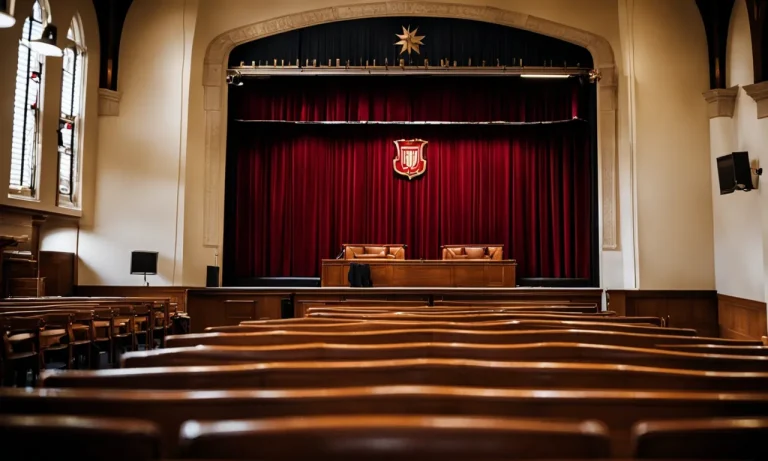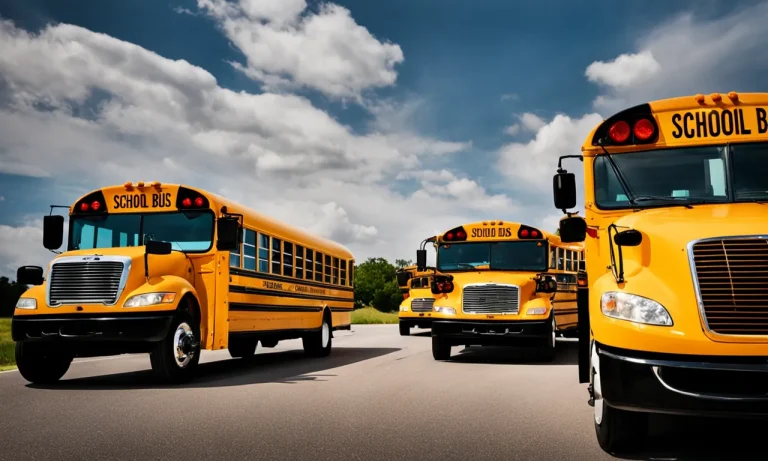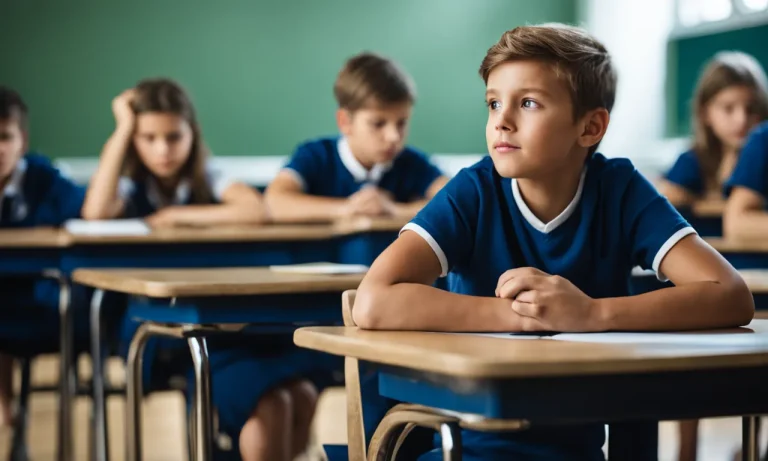Getting a referral in school can be a confusing and concerning experience for students and parents alike. If your child has recently received a referral, you likely have questions about what it means and what consequences it may have.
If you’re short on time, here’s a quick answer to your question: A referral in school is a formal documentation of a student’s inappropriate or disruptive behavior. It signals to school administration that disciplinary action may be needed.
In this comprehensive guide, we will explain everything you need to know about referrals in school. We’ll cover what kinds of behaviors warrant a referral, the referral process and how administrators handle them, the potential disciplinary actions and consequences, how it may affect a student’s permanent record, and tips for parents on dealing with a referral.
What is a Referral?
A referral in school refers to a formal documentation of inappropriate behavior exhibited by a student. It serves as a way to alert the school administration that disciplinary action may be needed. Referrals are typically issued by teachers or staff members when a student’s behavior disrupts the learning environment or violates school policies.
Formal documentation of inappropriate behavior
When a student’s behavior becomes disruptive or violates school rules, a referral is often issued as a formal documentation of the incident. This allows the school to keep a record of the student’s behavior and take appropriate action to address the issue.
Referrals may be given for a variety of reasons, such as fighting, bullying, cheating, or repeated defiance of authority.
By documenting the behavior in a referral, schools can maintain a record of incidents and identify patterns or trends that may require further intervention. This helps to ensure the safety and well-being of all students and maintain a conducive learning environment.
Alerts school administration disciplinary action may be needed
A referral also serves as an alert to the school administration that disciplinary action may be necessary. It provides a way for teachers and staff members to communicate concerns about a student’s behavior and seek appropriate support or consequences.
Once a referral is issued, the school administration will review the incident and determine the appropriate course of action. This may include counseling, detention, suspension, or other disciplinary measures depending on the severity of the behavior and the school’s policies.
It is important to note that referrals are not meant to be punitive measures, but rather a way to address behavioral issues and support students in making positive changes. Schools often have resources in place to help students who are struggling with behavior problems, such as counseling services or behavior intervention programs.
What Behaviors Lead to a Referral?
Classroom disruptions
One of the main behaviors that can lead to a referral in school is classroom disruptions. This includes actions such as talking out of turn, being excessively loud, or causing distractions that hinder the learning process for other students.
These disruptions can disrupt the flow of the lesson and make it difficult for the teacher to maintain control of the classroom. It is important for students to be aware of their behavior and its impact on the learning environment.
Insubordination
Insubordination refers to when a student refuses to follow the instructions or directions given by a teacher or school staff. This can include actions like talking back, refusing to complete assignments, or disregarding rules set by the school.
Insubordination can create a disruptive and disrespectful atmosphere in the classroom, making it necessary for teachers to address the issue and potentially issue a referral. It is crucial for students to understand the importance of respecting authority figures and following rules.
Physical aggression
Physical aggression, such as fighting or physically harming others, is a serious behavior that can lead to immediate referral. Schools have a zero-tolerance policy when it comes to physical violence as it poses a threat to the safety and well-being of students and staff.
Any form of physical aggression is taken seriously and should be reported immediately to the appropriate authorities. It is essential for students to learn conflict resolution skills and find peaceful ways to resolve their differences.
Bullying/harassment
Bullying and harassment are behaviors that can have severe consequences for both the victim and the perpetrator. These actions create a hostile and unsafe environment for students, and schools take them very seriously. Bullying can take many forms, including verbal, physical, or online harassment.
Students who engage in bullying or harassment may face disciplinary action, including referral. It is important for students to understand the impact of their actions and to treat others with kindness and respect.
View this post on Instagram
Dress code violations
While dress codes vary from school to school, violating the established dress code can result in a referral. Dress code violations may include wearing inappropriate or offensive clothing, revealing clothing, or clothing that promotes violence or drug use.
Dress codes are in place to maintain a professional and respectful environment in schools. Students should familiarize themselves with their school’s dress code policy and ensure they adhere to it to avoid any disciplinary action.
Technology misuse
The misuse of technology, such as cell phones or other electronic devices, can also lead to a referral. This includes using devices during class when prohibited, accessing inappropriate content, or engaging in cyberbullying.
Schools have policies in place regarding the appropriate use of technology, and students are expected to adhere to these guidelines. It is important for students to use technology responsibly and in a manner that respects the learning environment and the well-being of others.
The Referral Process
When it comes to addressing behavioral issues or concerns in a school setting, the referral process plays a crucial role in maintaining a safe and productive learning environment. Let’s take a closer look at the different steps involved in this process.
Teacher observation and documentation
The referral process typically begins with teacher observation and documentation. Teachers are often the first to notice any behavioral issues or concerns exhibited by a student. They carefully observe and document instances of disruptive behavior, academic struggles, or any other indicators that may warrant further attention.
This documentation is essential as it provides a clear record of the behavior in question. It helps establish a factual basis for the referral and ensures that the concerns are accurately communicated to the appropriate parties involved in the process.
Referring student to administration
Once a teacher has observed and documented concerning behavior, the next step is to refer the student to the administration. This referral is typically made to the principal, vice principal, or any designated authority figure responsible for handling disciplinary matters.
The referral may include a detailed description of the observed behavior, relevant documentation, and any other pertinent information that will aid in the investigation and resolution of the issue.
Administrative investigation
Upon receiving the referral, the administration initiates an investigation into the reported behavior. This investigation may involve gathering additional information from teachers, students, and any other relevant parties who may have witnessed or have knowledge of the incident.
The purpose of the investigation is to ensure a fair and thorough examination of the reported behavior. It helps in determining the validity of the concerns raised and identifying any underlying factors that may have contributed to the behavior.
Contacting parents
Once the administration has completed the initial investigation, they will typically contact the parents or guardians of the student involved. This communication is essential to keep parents informed about the concerns raised and to involve them in the resolution process.
During this communication, the administration may provide a summary of the investigation findings, discuss potential interventions or support services, and seek parental input or cooperation in addressing the behavior effectively.
Determining disciplinary action
After considering all the relevant information, including the investigation findings and input from the student’s parents or guardians, the administration determines the appropriate disciplinary action, if necessary.
The disciplinary action may vary depending on the severity and frequency of the behavior, as well as the school’s disciplinary policies.
This action could range from a verbal warning, detention, suspension, or in extreme cases, expulsion. The goal is to address the behavior, promote accountability, and ensure a safe and conducive learning environment for all students.
Understanding the referral process in schools is crucial in addressing behavioral issues effectively. By following a comprehensive and structured approach, schools can provide the necessary support and intervention to students while maintaining a positive and inclusive learning environment.
View this post on Instagram
Potential Disciplinary Actions
When a student engages in behavior that violates the school’s code of conduct, disciplinary actions may be taken. These actions are intended to address the misconduct and help the student understand the consequences of their actions.
Here are some potential disciplinary actions that a student may face:
Verbal warning
A verbal warning is often the first step taken by a teacher or administrator when a student misbehaves. It serves as a reminder to the student that their behavior is not acceptable and that they need to make better choices.
Verbal warnings are typically given in private and are intended to be a more informal way of addressing the issue.
Written warning
If a student’s behavior continues to be disruptive or inappropriate after a verbal warning, a written warning may be issued. This is a formal notice that is typically documented and shared with the student’s parents or guardians.
It outlines the specific behavior that needs to be corrected and the consequences that may result if the behavior persists.
Detention
Detention is a common disciplinary action that requires the student to stay after school for a specified period of time. During detention, the student is often required to complete additional schoolwork or reflect on their behavior.
It serves as a way to help the student understand the impact of their actions and encourages them to make better choices in the future.
In-school suspension
In-school suspension involves removing the student from their regular classroom and placing them in a designated area within the school. This disciplinary action allows the student to continue their academic work under supervision but isolates them from their peers.
In-school suspension is typically used for more serious or repeated offenses.
Out-of-school suspension
Out-of-school suspension involves temporarily removing the student from school for a specified period of time. This disciplinary action is typically reserved for more serious offenses that pose a threat to the safety of the student or others.
During the suspension, the student is not allowed to attend classes or participate in school activities.
Expulsion
Expulsion is the most severe disciplinary action that a student can face. It involves permanently removing the student from the school. Expulsion is typically reserved for very serious offenses that significantly impact the safety or well-being of others.
It is a last resort and is usually only considered after other disciplinary measures have been exhausted.
It is important to note that the specific disciplinary actions and policies may vary between schools and school districts. For more information on your school’s disciplinary policies, refer to your school’s student handbook or website.
How Referrals Affect Permanent Records
When a student receives a referral in school, the incident details are typically recorded in their permanent file. This means that any future educators or administrators who review the student’s file will have access to information about the incident.
The purpose of this documentation is to keep a record of disciplinary actions and to identify any patterns of misbehavior.
Details of incident go in student’s file
When a referral is issued, it is important for the school to gather all relevant information regarding the incident. This includes details such as the date, time, location, and a description of the behavior that led to the referral.
This information is then documented in the student’s permanent record, which can be accessed by school staff and potentially by future educational institutions or employers.
Having this information readily available allows educators to have a better understanding of the student’s behavior history and can help them make informed decisions about appropriate interventions or consequences.
Multiple referrals seen as pattern of misbehavior
If a student receives multiple referrals throughout their academic career, it can be seen as a pattern of misbehavior. Schools often view repeated referrals as a sign that the student may require additional support or intervention to address underlying issues that may be contributing to their behavior.
Multiple referrals can also lead to more severe consequences, such as suspension or expulsion, depending on the school’s disciplinary policies. It is important for students to understand the potential impact of their actions and to take responsibility for their behavior to avoid negative consequences.
Can impact college applications and employment background checks
Referrals can have implications beyond the school setting. When students apply to college or seek employment, their permanent records may be reviewed as part of the application or background check process.
While a single referral may not necessarily hinder their chances, a pattern of repeated referrals could raise concerns for admissions officers or potential employers.
View this post on Instagram
It is important for students to be mindful of their behavior and strive to make positive choices to avoid any potential negative consequences on their future educational and career opportunities.
It is crucial for parents, teachers, and students to work together to address behavior issues and prevent the need for referrals whenever possible. Open communication and a supportive environment can help students navigate challenges and make positive changes.
Tips for Parents
When dealing with a referral in school, it’s important for parents to approach the situation with patience and understanding. Here are some tips to help you navigate through this process:
Remain calm and get the full story
Upon receiving a referral, it’s natural for parents to feel concerned or even upset. However, it’s crucial to remain calm and gather all the facts before jumping to conclusions. Reach out to the school and schedule a meeting with the teacher or the administration to discuss the referral in detail.
By getting the full story, you can better understand the situation and work towards a solution.
Work cooperatively with the school
A referral is an opportunity for parents to collaborate with the school in addressing their child’s behavior. It’s essential to maintain open lines of communication and establish a cooperative relationship with the teachers and administrators.
By working together, parents and the school can develop a plan to support the student’s growth and development.
Help student reflect on behavior
After understanding the circumstances surrounding the referral, it’s important to help your child reflect on their behavior. Encourage them to think about the choices they made and the consequences that followed.
This self-reflection can help them develop a sense of responsibility and accountability for their actions.
View this post on Instagram
Discuss positive alternatives
Engage in conversations with your child about positive alternatives to the problematic behavior that led to the referral. Brainstorm together on how they can handle similar situations in a more constructive and respectful manner.
By focusing on positive alternatives, you can help your child develop problem-solving skills and make better choices in the future.
Monitor behavior and academic progress
Once a referral has been addressed, it’s crucial for parents to monitor their child’s behavior and academic progress. Regularly check in with the school to stay updated on your child’s performance and any improvements they are making.
By keeping a close eye on their progress, you can provide the necessary support and guidance to ensure their success.
Remember, a referral in school does not define your child’s future. It is an opportunity for growth and learning. By following these tips, parents can actively participate in their child’s development and help them navigate through challenging situations.
Conclusion
Getting a school referral can be upsetting, but try not to panic. The goal is correcting the behavior, not punishment. Work closely with administrators and your child to get back on track.
With a clearer understanding of what referrals are and how schools handle them, you can better support your child in improving their conduct. A referral doesn’t mean they are a bad kid – it’s just a signal more guidance is needed.
Remember, you play a key role in steering your child’s behavior and shaping them into a responsible, respectful adult. Partner with the school, but also spend time mentoring them at home.






